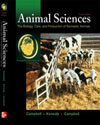
Selected Insects and Parasites of Significance to Humans and Animals |  |
Chapter Summary| Since the beginning of time humans have shared the planet with insects and parasites. Some are beneficial, others may transmit disease and inflict significant economic losses. Historically, diseases transmitted by insects have been notoriously effective in determining the outcome of military conflicts (Napoleon's army is said to have suffered greatly from typhus); some say even more effective than the decisions of military commanders (epidemic typhus and malaria are among the most telling).
Many protozoans are parasites. One type of amoeba destroys the intestinal linings of humans and causes the painful disease amoebic dysentery. Other protozoans may invade the blood of mammals and cause diseases such as malaria and Texas cattle fever. Bloodsucking insects and ticks collect microorganisms from infected animals and convey them to humans and other animals. Parasitic insects, mites, and ticks usually attack the skin. Certain ticks transmit Rocky Mountain spotted fever and Lyme disease to humans and animals. One type of mosquito spreads yellow fever and another carries malaria. The tsetse fly transmits African sleeping sickness. Humans may acquire typhus fever from a body louse.
The total mass of protoplasm produced annually by insects exceeds that produced by all other terrestrial (earthly) animal life combined. A knowledge concerning insects and how to circumvent their harmful effects is important if humans are to improve the health and productivity of animals that provide useful products and services to them. Great strides in parasite and insect control have been made possible through new and improved agricultural chemicals. (DDT saved millions of lives from malaria and typhus.) Pesticides allow humans to control arthropod-transmitted diseases and also to increase their food supplies by providing a means of combating agricultural pests that formerly attacked and destroyed crops and food animals. However, because of possible injurious effects of certain chemicals on humans, new methods of insect control are being studied and exploited. These include biological, physical, genetic, ecological, and/or cultural approaches. It seems almost certain that future control of insects will be largely biological and depend less on the use of pesticides.
Evidence of this trend is found in the heightened interest in integrated pest management. This technique stresses a thoughtful and balanced approach to pest control involving all appropriate technology available. It does not depend exclusively on biological, chemical, or cultural control but is based on maximum economic benefit within biological and ecological limits. Its most effective implementation requires a thorough understanding of the adverse effects of pest populations and in some cases computer models are used to predict future trends. Management decisions involving economic thresholds and injury levels are expected to be commonplace in the years ahead.
|
|
|